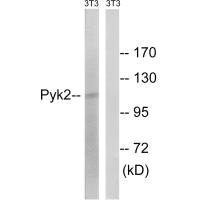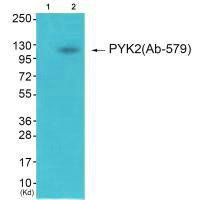
Western blot analysis of extracts from 3T3 cells, using PYK2 (Ab-579) antibody.
PTK2B (Ab-579) Antibody
CSB-PA213093
ApplicationsWestern Blot, ELISA
Product group Antibodies
ReactivityHuman, Mouse
TargetPTK2B
Overview
- SupplierCusabio
- Product NamePTK2B (Ab-579) Antibody
- Delivery Days Customer20
- ApplicationsWestern Blot, ELISA
- CertificationResearch Use Only
- ClonalityPolyclonal
- ConjugateUnconjugated
- Gene ID2185
- Target namePTK2B
- Target descriptionprotein tyrosine kinase 2 beta
- Target synonymsCADTK; CAKB; CAK-beta; calcium-dependent tyrosine kinase; calcium-regulated non-receptor proline-rich tyrosine kinase; cell adhesion kinase beta; FADK 2; FADK2; FAK2; focal adhesion kinase 2; PKB; proline-rich tyrosine kinase 2; protein kinase B; protein-tyrosine kinase 2-beta; PTK; PTK2B protein tyrosine kinase 2 beta; PYK2; RAFTK; related adhesion focal tyrosine kinase
- HostRabbit
- IsotypeIgG
- Protein IDQ14289
- Protein NameProtein-tyrosine kinase 2-beta
- Scientific DescriptionNon-receptor protein-tyrosine kinase that regulates reorganization of the actin cytoskeleton, cell polarization, cell migration, adhesion, spreading and bone remodeling. Plays a role in the regulation of the humoral immune response, and is required for normal levels of marginal B-cells in the spleen and normal migration of splenic B-cells. Required for normal macrophage polarization and migration towards sites of inflammation. Regulates cytoskeleton rearrangement and cell spreading in T-cells, and contributes to the regulation of T-cell responses. Promotes osteoclastic bone resorption; this requires both PTK2B/PYK2 and SRC. May inhibit differentiation and activity of osteoprogenitor cells. Functions in signaling downstream of integrin and collagen receptors, immune receptors, G-protein coupled receptors (GPCR), cytokine, chemokine and growth factor receptors, and mediates responses to cellular stress. Forms multisubunit signaling complexes with SRC and SRC family members upon activation; this leads to the phosphorylation of additional tyrosine residues, creating binding sites for scaffold proteins, effectors and substrates. Regulates numerous signaling pathways. Promotes activation of phosphatidylinositol 3-kinase and of the AKT1 signaling cascade. Promotes activation of NOS3. Regulates production of the cellular messenger cGMP. Promotes activation of the MAP kinase signaling cascade, including activation of MAPK1/ERK2, MAPK3/ERK1 and MAPK8/JNK1. Promotes activation of Rho family GTPases, such as RHOA and RAC1. Recruits the ubiquitin ligase MDM2 to P53/TP53 in the nucleus, and thereby regulates P53/TP53 activity, P53/TP53 ubiquitination and proteasomal degradation. Acts as a scaffold, binding to both PDPK1 and SRC, thereby allowing SRC to phosphorylate PDPK1 at Tyr-9, Tyr-373, and Tyr-376. Promotes phosphorylation of NMDA receptors by SRC family members, and thereby contributes to the regulation of NMDA receptor ion channel activity and intracellular Ca2+ levels. May also regulate potassium ion transport by phosphorylation of potassium channel subunits. Phosphorylates SRC; this increases SRC kinase activity. Phosphorylates ASAP1, NPHP1, KCNA2 and SHC1. Promotes phosphorylation of ASAP2, RHOU and PXN; this requires both SRC and PTK2/PYK2. Lev S., Nature 376:737-745(1995). Herzog H., Genomics 32:484-486(1996). Sasaki H., J. Biol. Chem. 270:21206-21219(1995).
- ReactivityHuman, Mouse
- Storage Instruction-20°C or -80°C
- UNSPSC12352203

